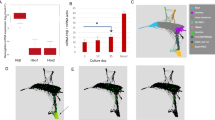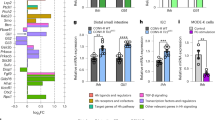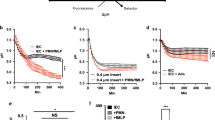Abstract
The neuronal guidance molecule netrin-1 is linked to the coordination of inflammatory responses. Given that mucosal surfaces are particularly prone to hypoxia-elicited inflammation, we sought to determine the function of netrin-1 in hypoxia-induced inflammation. We detected hypoxia-inducible factor 1α (HIF-1α)-dependent induction of expression of the gene encoding netrin-1 (Ntn1) in hypoxic epithelia. Neutrophil transepithelial migration studies showed that by engaging A2B adenosine receptor (A2BAR) on neutrophils, netrin-1 attenuated neutrophil transmigration. Exogenous netrin-1 suppressed hypoxia-elicited inflammation in wild-type but not in A2BAR-deficient mice, and inflammatory hypoxia was enhanced in Ntn1+/− mice relative to that in Ntn1+/+ mice. Our studies demonstrate that HIF-1α-dependent induction of netrin-1 attenuates hypoxia-elicited inflammation at mucosal surfaces.
This is a preview of subscription content, access via your institution
Access options
Subscribe to this journal
Receive 12 print issues and online access
$209.00 per year
only $17.42 per issue
Buy this article
- Purchase on Springer Link
- Instant access to full article PDF
Prices may be subject to local taxes which are calculated during checkout






Similar content being viewed by others
Change history
27 February 2015
In the version of this article initially published, the contrast in lane 4 of Figure 2c had been altered, and the top right image in Figure 5a and bottom right image Figure 6e were incorrect. The correct gel and images are now presented. The error has been corrected in the HTML and PDF versions of the article.
References
Sitkovsky, M. & Lukashev, D. Regulation of immune cells by local-tissue oxygen tension: HIF1α and adenosine receptors. Nat. Rev. Immunol. 5, 712–721 (2005).
Sitkovsky, M.V. et al. Physiological control of immune response and inflammatory tissue damage by hypoxia-inducible factors and adenosine A2A receptors. Annu. Rev. Immunol. 22, 657–682 (2004).
Cummins, E.P. et al. Prolyl hydroxylase-1 negatively regulates IκB kinase-β, giving insight into hypoxia-induced NFκB activity. Proc. Natl. Acad. Sci. USA 103, 18154–18159 (2006).
Walmsley, S.R. et al. Hypoxia-induced neutrophil survival is mediated by HIF-1α-dependent NF-κB activity. J. Exp. Med. 201, 105–115 (2005).
Rius, J. et al. NF-(B links innate immunity to the hypoxic response through transcriptional regulation of HIF-1α. Nature 453, 807–811 (2008).
Eckle, T. et al. A2B adenosine receptor dampens hypoxia-induced vascular leak. Blood 111, 2024–2035 (2008).
Eltzschig, H.K. et al. HIF-1-dependent repression of equilibrative nucleoside transporter (ENT) in hypoxia. J. Exp. Med. 202, 1493–1505 (2005).
Eltzschig, H.K. et al. Coordinated adenine nucleotide phosphohydrolysis and nucleoside signaling in posthypoxic endothelium: role of ectonucleotidases and adenosine A2B receptors. J. Exp. Med. 198, 783–796 (2003).
Eltzschig, H.K. et al. Endogenous adenosine produced during hypoxia attenuates neutrophil accumulation: coordination by extracellular nucleotide metabolism. Blood 104, 3986–3992 (2004).
Morote-Garcia, J.C., Rosenberger, P., Kuhlicke, J. & Eltzschig, H.K. HIF-1-dependent repression of adenosine kinase attenuates hypoxia-induced vascular leak. Blood 111, 5571–5580 (2008).
Synnestvedt, K. et al. Ecto-5′-nucleotidase (CD73) regulation by hypoxia-inducible factor-1 mediates permeability changes in intestinal epithelia. J. Clin. Invest. 110, 993–1002 (2002).
De Perrot, M. et al. Interleukin-8 release during early reperfusion predicts graft function in human lung transplantation. Am. J. Respir. Crit. Care Med. 165, 211–215 (2002).
Naka, Y., Toda, K., Kayano, K., Oz, M.C. & Pinsky, D.J. Failure to express the P-selectin gene or P-selectin blockade confers early pulmonary protection after lung ischemia or transplantation. Proc. Natl. Acad. Sci. USA 94, 757–761 (1997).
Yang, Z. et al. Infarct-sparing effect of A2A-adenosine receptor activation is due primarily to its action on lymphocytes. Circulation 111, 2190–2197 (2005).
Eckle, T., Kohler, D., Lehmann, R., El Kasmi, K.C. & Eltzschig, H.K. Hypoxia-inducible factor-1 Is central to cardioprotection: a new paradigm for ischemic preconditioning. Circulation 118, 166–175 (2008).
Eckle, T. et al. Cardioprotection by ecto-5′-nucleotidase (CD73) and A2B adenosine receptors. Circulation 115, 1581–1590 (2007).
Kohler, D. et al. CD39/ectonucleoside triphosphate diphosphohydrolase 1 provides myocardial protection during cardiac ischemia/reperfusion injury. Circulation 116, 1784–1794 (2007).
Grenz, A. et al. The reno-vascular A2B adenosine receptor protects the kidney from ischemia. PLoS Med. 5, e137 (2008).
Hart, M.L. et al. Extracellular adenosine production by ecto-5′-nucleotidase protects during murine hepatic ischemic preconditioning. Gastroenterology 135, 1739–1750 (2008).
Guckelberger, O. et al. Beneficial effects of CD39/ecto-nucleoside triphosphate diphosphohydrolase-1 in murine intestinal ischemia-reperfusion injury. Thromb. Haemost. 91, 576–586 (2004).
Hart, M.L. et al. Role of extracellular nucleotide phosphohydrolysis in intestinal ischemia-reperfusion injury. FASEB J. 22, 2784–2797 (2008).
Karhausen, J., Ibla, J.C. & Colgan, S.P. Implications of hypoxia on mucosal barrier function. Cell Mol Bio 49, 77–87 (2003).
Fredholm, B.B. Adenosine, an endogenous distress signal, modulates tissue damage and repair. Cell Death Differ. 14, 1315–1323 (2007).
Weissmuller, T. et al. PMNs facilitate translocation of platelets across human and mouse epithelium and together alter fluid homeostasis via epithelial cell-expressed ecto-NTPDases. J. Clin. Invest. 118, 3682–3692 (2008).
Cramer, T. et al. HIF-1alpha is essential for myeloid cell-mediated inflammation. Cell 112, 645–657 (2003).
Karhausen, J. et al. Epithelial hypoxia-inducible factor-1 is protective in murine experimental colitis. J. Clin. Invest. 114, 1098–1106 (2004).
Robinson, A. et al. Mucosal protection by hypoxia-inducible factor prolyl hydroxylase inhibition. Gastroenterology 134, 145–155 (2008).
Peyssonnaux, C. et al. HIF-1α expression regulates the bactericidal capacity of phagocytes. J. Clin. Invest. 115, 1806–1815 (2005).
Cummins, E.P. et al. The hydroxylase inhibitor dimethyloxalylglycine is protective in a murine model of colitis. Gastroenterology 134, 156–165 (2008).
Kempf, V.A. et al. Activation of hypoxia-inducible factor-1 in bacillary angiomatosis: evidence for a role of hypoxia-inducible factor-1 in bacterial infections. Circulation 111, 1054–1062 (2005).
Ly, N.P. et al. Netrin-1 inhibits leukocyte migration in vitro and in vivo. Proc. Natl. Acad. Sci. USA 102, 14729–14734 (2005).
Dickson, B.J. Molecular mechanisms of axon guidance. Science 298, 1959–1964 (2002).
Tessier-Lavigne, M. & Goodman, C.S. The molecular biology of axon guidance. Science 274, 1123–1133 (1996).
Chedotal, A., Kerjan, G. & Moreau-Fauvarque, C. The brain within the tumor: new roles for axon guidance molecules in cancers. Cell Death Differ. 12, 1044–1056 (2005).
Yamashita, R. et al. DBTSS: DataBase of human transcription start sites, progress report 2006. Nucleic Acids Res. 34, D86–D89 (2006).
Wenger, R.H., Stiehl, D.P. & Camenisch, G. Integration of oxygen signaling at the consensus HRE. Sci. STKE 2005, re12 (2005).
Chin, A.C. & Parkos, C.A. Pathobiology of neutrophil transepithelial migration: implications in mediating epithelial injury. Annu Rev Pathol 2, 111–143 (2007).
Corset, V. et al. Netrin-1-mediated axon outgrowth and cAMP production requires interaction with adenosine A2b receptor. Nature 407, 747–750 (2000).
Ledent, C. et al. Aggressiveness, hypoalgesia and high blood pressure in mice lacking the adenosine A2a receptor. Nature 388, 674–678 (1997).
Yang, D. et al. The A2B adenosine receptor protects against inflammation and excessive vascular adhesion. J. Clin. Invest. 116, 1913–1923 (2006).
Moore, S.W., Tessier-Lavigne, M. & Kennedy, T.E. Netrins and their receptors. Adv. Exp. Med. Biol. 621, 17–31 (2007).
Komatsuzaki, K., Dalvin, S. & Kinane, T.B. Modulation of Giα2 signaling by the axonal guidance molecule UNC5H2. Biochem. Biophys. Res. Commun. 297, 898–905 (2002).
Kong, T., Westerman, K.A., Faigle, M., Eltzschig, H.K. & Colgan, S.P. HIF-dependent induction of adenosine A2B receptor in hypoxia. FASEB J. 20, 2242–2250 (2006).
Eltzschig, H.K. et al. Endothelial catabolism of extracellular adenosine during hypoxia: the role of surface adenosine deaminase and CD26. Blood 108, 1602–1610 (2006).
Serafini, T. et al. Netrin-1 is required for commissural axon guidance in the developing vertebrate nervous system. Cell 87, 1001–1014 (1996).
Thiel, M. et al. Oxygenation inhibits the physiological tissue-protecting mechanism and thereby exacerbates acute inflammatory lung injury. PLoS Biol. 3, e174 (2005).
Kojima, H. et al. Abnormal B lymphocyte development and autoimmunity in hypoxia-inducible factor 1α-deficient chimeric mice. Proc. Natl. Acad. Sci. USA 99, 2170–2174 (2002).
Stein, E., Zou, Y., Poo, M. & Tessier-Lavigne, M. Binding of DCC by netrin-1 to mediate axon guidance independent of adenosine A2B receptor activation. Science 291, 1976–1982 (2001).
McKenna, W.L. et al. Netrin-1-independent adenosine A2b receptor activation regulates the response of axons to netrin-1 by controlling cell surface levels of UNC5A receptors. J. Neurochem. 104, 1081–1090 (2008).
Eckle, T., Grenz, A., Laucher, S. & Eltzschig, H.K. A2B adenosine receptor signaling attenuates acute lung injury by enhancing alveolar fluid clearance in mice. J. Clin. Invest. 118, 3301–3315 (2008).
Acknowledgements
We thank M. Faigle, D. Köhler and S. Laucher for technical support; Bayer Healthcare for BAY 60-6583; and S.P. Colgan (University of Colorado Denver), M. Tessier-Lavigne (Genentech) and C. Ledent (Université Libre de Bruxelles) for breeding pairs of gene-targeted mice. Supported by the University of Tübingen (Fortüne grants 1639-0-0 to P.R. and 1778-0-0 to V.M.), Deutsche Forschungsgemeinschaft (EL 274/2-1 to H.K.E., and EL 274/2-1 and RO 3671/2-1 to P.R.) and the Foundation for Anesthesia Education and Research (H.K.E.).
Author information
Authors and Affiliations
Contributions
P.R. did most in vitro and all in vivo experiments, analyzed and interpreted the data, and wrote parts of the manuscript; J.M.S. provided the initial idea, helped with the design of the research and interpretation of data; V.M. helped with in vivo studies and data analysis; E.M. did part of the in vitro studies; A.M. studied cAMP responses elicited by netrin-1; J.C.M.-G. helped with in vivo studies; K.U. helped with data interpretation, reviewed the manuscript and helped with writing; and H.K.E. designed the research and wrote the manuscript.
Note: Supplementary information is available on the Nature Immunology website.
Corresponding author
Supplementary information
Supplementary Text and Figures
Supplementary Figures 1–4, Tables 1–4 and Supplementary Methods (PDF 434 kb)
Rights and permissions
About this article
Cite this article
Rosenberger, P., Schwab, J., Mirakaj, V. et al. Hypoxia-inducible factor–dependent induction of netrin-1 dampens inflammation caused by hypoxia. Nat Immunol 10, 195–202 (2009). https://doi.org/10.1038/ni.1683
Received:
Accepted:
Published:
Issue Date:
DOI: https://doi.org/10.1038/ni.1683
This article is cited by
-
The role of oxygen tension in cell fate and regenerative medicine: implications of hypoxia/hyperoxia and free radicals
Cell and Tissue Banking (2024)
-
Hypofucosylation of Unc5b regulated by Fut8 enhances macrophage emigration and prevents atherosclerosis
Cell & Bioscience (2023)
-
Reduced expression of phosphorylated ataxia-telangiectasia mutated gene is related to poor prognosis and gemcitabine chemoresistance in pancreatic cancer
BMC Cancer (2023)
-
A click chemistry-mediated all-peptide cell printing hydrogel platform for diabetic wound healing
Nature Communications (2023)
-
Netrin-1 and RGMa: Novel Regulators of Atherosclerosis-Related Diseases
Cardiovascular Drugs and Therapy (2023)



